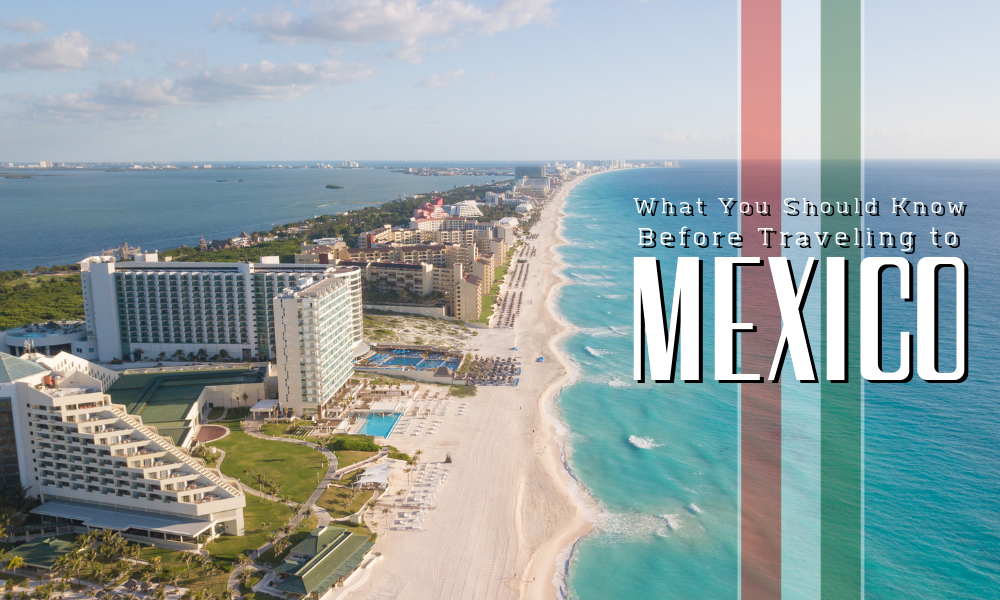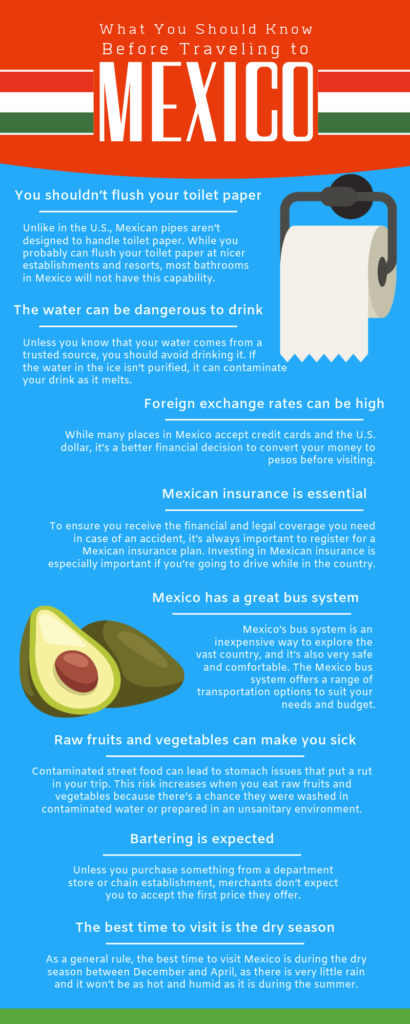
Mexico is a breathtaking country full of stunning beaches, amazing food, vibrant culture, and unique experiences—the reason why 74 percent of Americans take vacations. When traveling to a foreign country, it’s important to be knowledgeable of any cultural or lifestyle differences so you can avoid any inconveniences or health and safety issues. If you want to pay a visit south of the border, we highlight what you should know before traveling to Mexico so you can have the best trip possible.
You shouldn’t flush your toilet paper
Flushing your toilet paper in Mexico will often result in a clogged toilet. Unlike in the U.S., Mexican pipes aren’t designed to handle toilet paper. While you probably can flush your toilet paper at nicer establishments and resorts, most bathrooms in Mexico will not have this capability. Instead, make sure to toss your toilet paper in the small waste bin by the toilet to avoid any embarrassing and inconvenient plumbing issues.
The water can be dangerous to drink
The rumors about Mexican water causing illnesses and painful stomach issues are true. Unless you know that your water comes from a trusted source, you should avoid drinking it. It’s also important to recognize that even if the establishment uses filtered water, the water for their ice may not be. While most ice in Mexico is made in factories that use filtered water, this isn’t always the case. Even if your beverage comes from a trusted resort or nice restaurant, you should always be cautious of drinking beverages. If the water in the ice isn’t purified, it can contaminate your drink as it melts. As an additional precaution, you should also avoid brushing your teeth with tap water to reduce the risk of illness.
Foreign exchange rates can be high
Not paying with pesos in Mexico could end up costing you a lot of money on your trip. While many places in Mexico accept credit cards and the U.S. dollar, it’s a better financial decision to convert your money to pesos before visiting. This is because merchant foreign currency exchange rates and bank fees can be very high if you choose to purchase goods with U.S. money. To avoid wasting money, exchange your currency before traveling to Mexico or pay using a credit card that doesn’t have foreign transaction fees.
Mexican insurance is essential
Most U.S. insurance plans aren’t accepted in Mexico. To ensure you receive the financial and legal coverage you need in case of an accident, it’s always important to register for a Mexican insurance plan. Investing in Mexican insurance is especially important if you’re going to drive while in the country. Auto insurance for Mexico travel won’t just help you cover legal, medical, and property fees in case of an accident, it’s also required by law. If you get into an accident in Mexico and aren’t covered by a valid Mexican insurance plan, you could be forced to pay exorbitant fees and may have to go to jail—even if it’s just a minor fender bender. Additional types of insurance that are important to have while in Mexico include boating insurance, medical insurance, and kidnap and ransom insurance. Proper coverage will make your trip much safer and you’ll be less stressed knowing you’re protected in the event of an accident.
Mexico has a great bus system
If you’re planning a trip to Mexico, don’t be afraid to take public transportation. Mexico’s bus system is an inexpensive way to explore the vast country, and it’s also very safe and comfortable. The Mexico bus system offers a range of transportation options to suit your needs and budget. The tiered system includes three classes: deluxe and executive, first class, and second class. The deluxe and executive class options—called de lujo, primera plus, and ejecutivo—are often considered to be nicer than most U.S. busses. They include onboard restrooms, movies on individual video screens, and comfortable seating that rivals a first-class airline. The lower-class buses take more stops and don’t have onboard restrooms. They do, however, come at a cheaper price tag and are still a quality transportation option for budget travelers.
Raw fruits and vegetables can make you sick
The street food in Mexico is often delicious, but it also comes with some risks. Contaminated street food can lead to stomach issues that put a rut in your trip. This risk increases when you eat raw fruits and vegetables because there’s a chance they were washed in contaminated water or prepared in an unsanitary environment. In addition, if food was left to sit out for a long period of time, insects may have contaminated it. It’s much safer to eat hot foods. If you do choose to eat raw foods, make sure they were prepared by a trusted source.
Bartering is expected
Bartering is a common practice in Mexico. Unless you purchase something from a department store or chain establishment, merchants don’t expect you to accept the first price they offer. While you barter, it’s important to be respectful and avoid being overly stubborn or aggressive. Asking for a much lower price than their initial offer can also be seen as a devaluation of their work—which is often handcrafted and serves as their primary source of income. While you shouldn’t accept the first price offered, you should be realistic with your own offers. For a successful bartering experience, have an idea of the maximum price you’re willing to pay before entering into an exchange, and be prepared to walk away if you can’t come to an agreement.
The best time to visit is during the dry season
The ideal time to visit Mexico will depend on your preference and the region of the country you want to visit. All travelers, however, should avoid visiting coastal areas during hurricane season which typically peaks between August and October. As a general rule, the best time to visit Mexico is during the dry season between December and April, as there is very little rain and it won’t be as hot and humid as it is during the summer. If you’re on a budget, you shouldn’t plan your trip during Christmas or New Year’s, as this is often the most popular and expensive time to visit Mexico.



